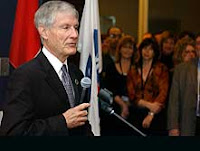 Dr. Bruce Cordell, over at the 21st Century Waves blog, often writes about science education as being the major driver of economic competitiveness so it's no surprise that his latest post, titled "Californian's Reveal the Secret of the Future" focuses on the recently released National Academies of Sciences and Engineering report which concluded (again) that science education is a major economic driver.
Dr. Bruce Cordell, over at the 21st Century Waves blog, often writes about science education as being the major driver of economic competitiveness so it's no surprise that his latest post, titled "Californian's Reveal the Secret of the Future" focuses on the recently released National Academies of Sciences and Engineering report which concluded (again) that science education is a major economic driver. It's also not uprising that a great many Canadian organizations feel the same way. These include the Science Technology and Innovation Council (STIC) in their May 5, 2009 document titled "Science, Technology and Innovation Council finds Canada a solid performer in science, technology and innovation — but needs to aim higher on the world stage" and the Conference Board of Canada in their document "How Canada Performs 2009" which was released in March 2010.
But what is uprising is that Canadian space focused organizations are finally beginning to take notice of this correlation. Chief among them are members of the Canadian Aeronautics and Space Institute (CASI) which is partnering with Richmond, BC based Geocentrix Technologies Ltd to launch the Canadian Satellite Design Challenge (CSDC).
According to the CSDC website:
The contest was formally announced on September 22nd, 2010 but has been in the organizational and planning stages for some time according to the CSDC website. Corporate sponsors include MITACS, MacDonald Dettwiller (MDA,) Microsat Systems Canada, Neptec Design Group, ABB Canada, Magellan Aerospace, AppSpace Solutions, Analytical Graphics, Manitoba Aerospace, NEI Software, the Canadian Space Society and quite a few others.The primary objective of the challenge is for teams of university students (undergraduate and graduate) to design and build an operational small-satellite, based on commercially-available, "off-the-shelf" components.
The satellites will undergo full launch and space environment qualification, and the ultimate goal of the CSDC is to launch the winning satellite into orbit in order to conduct science research.
The CSDC will begin at participating universities and colleges in September, 2010; the winning satellite(s) will be selected in October, 2012.
It's likely coincidental that Geocentrix is located within driving distance of a gentleman named John Chapman. Last fall Chapman wrote a letter to Canadian Space Agency (CSA) President Steve MacLean seeking support to create a system of prizes for Canadian universities, businesses and individuals, similar to the NASA Centennial Challenges.
According to my November 17, 2009 post "Preparing for the Next Great Canadian Gold Rush," Chapman felt that “someone needs to be the Western Canadian champion” for this sort of activism to train the next generation of engineers, experts and space focused entrepreneurs.
Since Mr. MacLean never responded to Mr. Chapman's letter, it seems clear that things are moving ahead without CSA participation. The next Western Canadian space champion is likely going to be working for Geocentrix or maybe even someone else in CASI, but probably not for the CSA.


